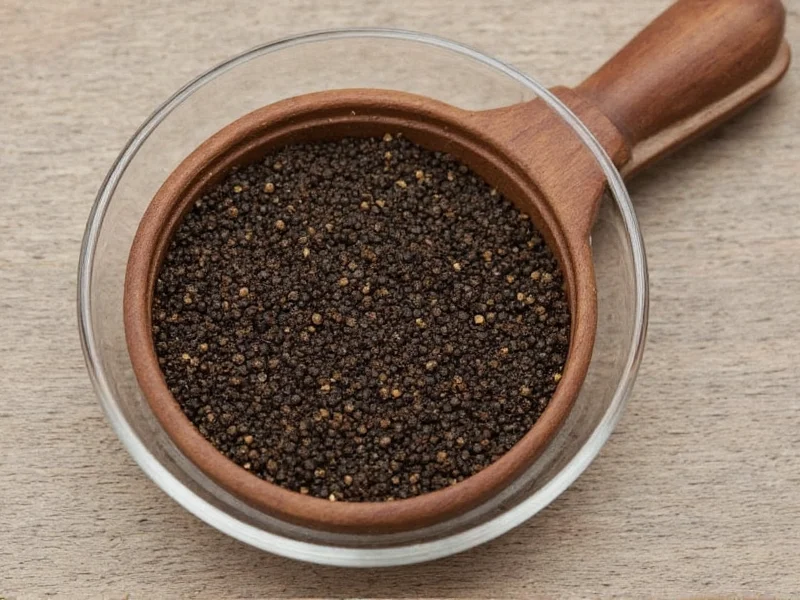Understanding how black pepper is made reveals a centuries-old agricultural process that transforms simple berries into one of the world's most popular spices. This natural transformation occurs through careful harvesting and sun-drying techniques perfected over generations in tropical growing regions.
The Piper Nigrum Vine: Source of Black Pepper
Black pepper originates from Piper nigrum, a flowering vine native to South India's Malabar Coast. Today, Vietnam, Indonesia, India, Brazil, and Madagascar produce over 80% of the world's black pepper. The vine requires specific tropical conditions: consistent temperatures between 75-85°F (24-29°C), high humidity, and well-drained soil. Farmers typically grow these climbing vines on support trees or trellises, where they can reach heights of 30 feet when mature.
Harvesting: Timing is Everything
The production of black pepper begins with precise harvesting. Unlike white pepper (made from fully ripe berries), black pepper requires picking the peppercorns when they're still unripe and green, typically 5-7 months after flowering. Experienced harvesters recognize the optimal window when the fruit spike begins to turn from green to yellow but before full ripening. This timing is crucial for developing black pepper's distinctive flavor profile during processing.
The Transformation Process: From Green to Black
The magic of black pepper production happens during the drying phase. After harvesting, processors spread the green peppercorns in thin layers on mats or concrete surfaces under direct sunlight. This sun-drying process typically lasts 5-7 days, during which several critical changes occur:
| Processing Stage | Duration | Physical Changes | Chemical Changes |
|---|---|---|---|
| Initial Sun Exposure | 24-48 hours | Green color darkens to olive | Enzymes begin breaking down chlorophyll |
| Mid-Processing | 3-4 days | Surface wrinkles appear | Piperine formation accelerates |
| Final Drying | 5-7 days | Shrinks to 1/5 original size, turns black | Moisture drops to 10-12%, flavor compounds stabilize |
This natural enzymatic browning—similar to how an apple turns brown when cut—is what gives black pepper its characteristic dark color and complex flavor. The peppercorns lose approximately 75% of their moisture content during this process, concentrating the essential oils and piperine that create pepper's signature heat.
Traditional vs. Modern Processing Methods
While sun-drying remains the gold standard for premium black pepper production, some commercial operations use mechanical dryers to accelerate the process. However, traditional sun-drying produces superior flavor complexity because the slower drying allows for more complete enzymatic reactions. The best quality black pepper undergoes this natural transformation without any additives, chemicals, or artificial coloring—just time, sunlight, and careful monitoring.
Historical Evolution of Processing Techniques
Black pepper processing has evolved over centuries while maintaining its core sun-drying principle. Key milestones include:
| Time Period | Development | Impact on Production |
|---|---|---|
| Ancient Era (Pre-1500 CE) | Exclusive sun-drying in South India's Malabar Coast | Established enzymatic browning as standard method; limited by seasonal weather patterns |
| 16th-18th Century | Portuguese and Dutch trade expansion to Southeast Asia | Spread cultivation to Indonesia and Malaysia; introduced regional drying variations while preserving core technique |
| 19th Century | Introduction of mechanical drying trials | Early attempts to reduce weather dependency; often resulted in inferior flavor profiles compared to sun-drying |
| Late 20th Century | Refined mechanical drying with temperature control | Commercial operations adopted hybrid methods; premium producers maintained traditional sun-drying for quality |
Sources: Food and Agriculture Organization (FAO) of the United Nations (Pepper Production Guidelines), Encyclopaedia Britannica (Pepper History).
Environmental Constraints in Traditional Production
While sun-drying produces superior flavor, it faces significant environmental limitations that affect global production consistency:
- Geographic Restriction: Only regions within 20° north and south of the equator provide suitable tropical conditions for Piper nigrum cultivation (FAO, 2000). Attempts to grow the vine outside this zone fail due to temperature sensitivity.
- Seasonal Vulnerability: Monsoon seasons in major producing countries (like Vietnam's rainy season from May-October) can disrupt sun-drying, causing mold growth if peppercorns aren't protected (FAO, 2000).
- Quality Trade-offs: Mechanical drying solves weather issues but requires precise temperature control (40-50°C); exceeding 60°C degrades piperine content by up to 30% (Wang et al., 2018).
These constraints explain why premium black pepper remains a seasonal and region-specific product despite global demand.
Quality Grading and Sorting
After drying, processors sort the peppercorns by size, color, and density. Higher quality grades feature uniform black color, consistent size (typically 3.5-5mm in diameter), and minimal foreign matter. The most prized varieties, like Tellicherry extra bold from India or Lampong from Indonesia, undergo additional hand-sorting to ensure only the largest, most mature peppercorns make the premium grade. This meticulous sorting directly impacts the final flavor intensity and aroma.
Black Pepper vs. Other Pepper Varieties
Understanding how black pepper is made helps distinguish it from other pepper types:
- White pepper comes from fully ripe berries with the outer layer removed through soaking
- Green pepper is made by preserving unripe berries through freeze-drying or sulfur dioxide treatment
- Red pepper uses fully ripe berries that are quickly dried to retain some color
Each variety's unique processing method creates distinct flavor profiles, but only black pepper undergoes the specific sun-drying process that develops its characteristic pungency and complex aroma notes.
Common Misconceptions About Black Pepper Production
Many consumers wonder whether black pepper's dark color comes from artificial coloring or chemical treatment. Authentic black pepper requires no additives—the color develops naturally through enzymatic browning during sun-drying. Another misconception is that black pepper contains significant amounts of capsaicin (like chili peppers); in reality, its heat comes from piperine, a different compound that affects taste receptors differently.











 浙公网安备
33010002000092号
浙公网安备
33010002000092号 浙B2-20120091-4
浙B2-20120091-4